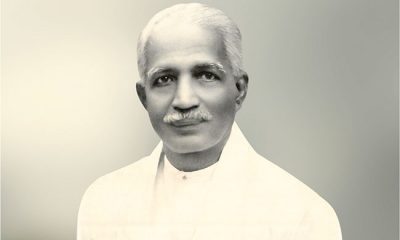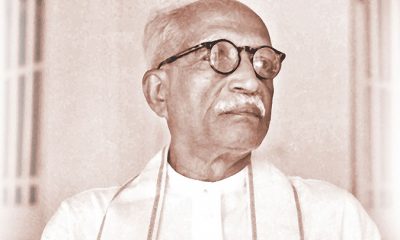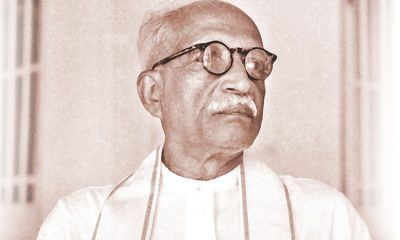Features
Educational reforms Sri Lanka demands today for a brighter tomorrow
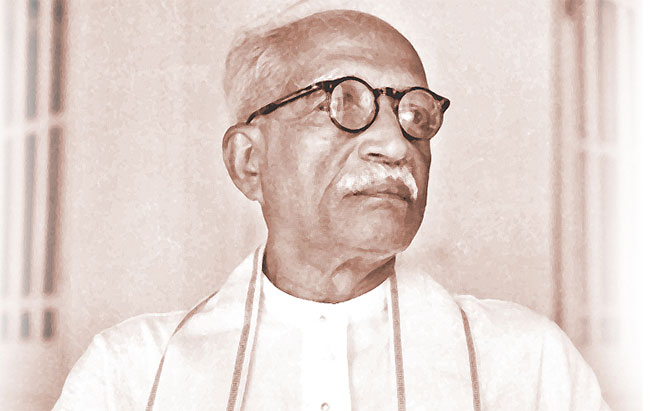
The 32nd Dr. C. W. W. Kannangara Memorial Lecture titled ‘For a country with a future’: Educational reforms Sri Lanka demands today’ delivered by Prof. Athula Sumathipala, Director, Institute for Research and Development, Sri Lanka and Chairman, National Institute of Fundemental Studies, Hanthana, on Oct 13, at the National Institute of Education, Maharagama
Continued From Tuesday (25)
Research on the current school education system, in Sri Lanka, has indicated that teachers recruited for maths and science education are often placed in schools without adequate teacher education and professional development. Short-term training sessions for these teachers are primarily carried out by Teacher Centres and Divisional Education Offices. These in-service training sessions need to be modernised to help provide teachers with the knowledge, attitudes, skills, and values to meet the demands for high-quality teachers. It is a weakness, within the system, that there is no national level consensus on the objectives to be met on Sri Lanka’s teacher education and professional development. A number of institutions work on this matter in isolation, and an eminent Sri Lankan educator, Dr. G. B. Gunewardena, stated, in 2012, that it is a necessity to have a confluent system to liaise between all these separate institutions. It is also necessary to further study the effectiveness of in-service training sessions in improving the quality of teachers.
Principals’ professional
development
This is not a factor that has received much attention in the Sri Lankan education system. All that usually happens is that the divisional/provincial education office informs principals when a new circular is issued. This has led to principals focusing more on meeting the responsibilities imposed upon them, by senior officers, and working according to the circulars, rather than on working on their responsibilities towards students and teachers nor on attempting to build a high-quality education system. There is very limited research on professional development of principals.
The key institution that offers professional development training to Sri Lankan principals is the Faculty of Education Leadership, Development and Management affiliated with the National Institute of Education. It is, however, very difficult for principals from areas faraway from Colombo to attend such trainings. Travel and financial difficulties, and the resistance to residential courses, are the key problems, whereas there is also no motivating factor for principals to participate in such programmes. It is, therefore, rare that principals, from far away areas, such as Ampara, for example, opt for continuous professional development.
However, it is clear that the number of principals participating in these trainings has increased as the training has moved to online learning. This is clearly a benefit of online education. Research on education systems in other countries has shown that although online education is less successful for school children, it can be highly effective in adult education.
For the new educational reforms to be truly effective, it is important to emphasise on the need to consider the bigger picture. Accordingly, a significant change in the mentality of students, teachers and society that helps place teachers and the teaching profession at an honoured and optimal level is necessary.
(vii) Integrating research within the overall scheme of education
Children are by nature researchers. They are inquisitive and explore the world from the day they are born. Children want to know everything; they question everything they see. Some children take apart toys to see how the toy works. This is science. Scientists, who investigate the world, are those who do what children do, in a professional and systematic manner. In this sense, every child is a researcher and a scientist. Researchers go beyond asking questions. They seek answers, or solutions, to the problem, based on research methods, make observations, arrive at conclusions, based on the observed data, and derive theories from it.
It is, therefore, easy to turn every child into a researcher and explorer. It is questionable as to what extent our education system achieves this objective. The group and individual project work introduced for G.C.E. Advanced Level students was an excellent opportunity to achieve such an objective. However, it appears that the value of this project work was not fully appreciated, and, perhaps, because of it, individual project work was removed from the Advanced Level Syllabus. I do not believe there is sufficient emphasis on research. even within the university system. Moreover, research projects are frequently concluded with the limited objective of obtaining career promotion.
Research and development, innovation and
technological transformation
The post-industrial knowledge economy and its growth is closely interlinked with innovation and localised research capacity. University-based research has been shown to be an effective driver for such economically productive innovation. In order to remain globally competitive, it is, therefore, necessary for a country to utilise state investment in universities to stimulate research and development. In line with this global trend, most top Asian Universities have transformed, from ‘Teaching Universities’ to ‘Research Universities’.
A paradigm shift is required in Sri Lankan graduate and post-graduate education to position research and innovation as a key feature and to develop persons with the creative vision for innovation, along with the wide and deep knowledge necessary to convert that vision into a reality. Contribution from research and development is critically necessary for Sri Lanka to stabilise its economy, to ensure national security and for the sustainable development of strategically important sectors. Strategy should focus on capturing available opportunities in a dynamic world since scientific opportunity cannot often be predicted. Flexibility in responding to novel ideas and seizing available opportunities is important for success. For example, the knowledge gaps that were exposed during Covid-19 created unprecedented opportunity for research on as yet unexplored fields. It is also necessary to create mechanisms in co-operation with industry, for the commercial exploitation of innovative products arising from the research, as well as for knowledge creation and transfer.
Sri Lanka urgently needs reforms in higher education that lead to establishing a value chain of co-operation and integration between multiple fields, which can ultimately result in innovation being converted to new products and services. Mere imitation of what is being done in this regard in foreign countries will not, however, suffice in this instance. An in-depth study of the geographic, cultural and socio-economic factors that can impact the relationship between universities and industry is necessary, and these findings should be used to determine a model best suited to Sri Lanka.
Co-operation between universities and industry on innovative products should be developed within a format that benefits all stakeholders. Capacity building, job creation and creation of intellectual property should also be included as part of this process. The research agenda of higher education institutions should, therefore, be developed within a structured framework of scientific, economic and social factors, that can lead to practical solutions for supporting innovation, technological development and its disbursement.
Innovation ecosystem model is a mechanism that has successfully been adopted by many countries and economies with a research and development agenda, and this could be used to help convert Sri Lankan universities into innovation centres where research and development projects are carried out. Accelerating innovation requires the cumulative action and support of a research-friendly vision and culture, legal and regulatory framework, financial and human resources, infrastructure and finally, supportive end-market users. To identify the best mechanisms to stimulate innovation in areas where Sri Lanka has a competitive edge, the innovation process should be considered in its entirety, bearing in mind the inter-dependencies between various stakeholders.
As the first step, research prioritisation should be carried out to identify the sectors which are necessary for post-Covid economic restructuring. Priority should be given to areas such as health, nutrition, food security, import substitution and export promotion. Technological innovation can be used to investigate areas such as online learning, environmental protection, increasing local production, and renewable energy sources such as solar, wind and tidal energy. Policy-making, at a national level, should be evidence-based and universities should be encouraged to play a pivotal role in this endeavour.
Secondly, research and development centres should be created with a global vision, adhering to the highest quality measures and research should be carried out on the most globally relevant fields, so that these institutions and the research benefits generated remain globally competitive. Building effective links with globally reputed research and development institutions, entrepreneurs and industry can add further value to Sri Lankan universities and entrepreneurs, leading to further national development.
In order to arrive at this transformation, attention needs to be paid to increasing resources through investment, identifying and utilising skilled human resources, recruiting and retaining the best researchers and innovators, and to carrying out critically necessary structural changes. Further, key factors necessary are: establishing the highest quality research centres, collective action to raise funds including sourcing donations, and, improving the ability to compete for international research funding. A ‘Department for sourcing, supporting and managing research funding’ should be established at university level. Post-graduate programmes should be structured around key research projects that can lead to effective outputs.
For knowledge creation, it is necessary to strengthen research in Sri Lankan universities.
The focus of research should shift from publishing research papers and using it for promotion towards commercial development of the outcomes of the research.
The new knowledge created from research should be useful for socio-economic development, yielding returns to the public. It is necessary to address the loopholes in this process, to remove obstacles and create opportunities for research that leads to intellectual property creation, innovation and commercialisation. The University Act could be used for this purpose.
Research findings should be used to inform policy-making at national, regional and international levels.
The obstacles to bringing in competitively won research funding from reputed foreign research funding institutions into the country, should be removed urgently.
We need to clearly understand that we live in an era which demands not one Dr. Kannangara but hundreds of, thousands of, Dr. Kannagaras in order to overcome the challenges ahead of us.
The single mechanism to overcome the multiple crises Sri Lanka faces now is to create productive citizens meeting the requirements of the modern world. Finally, I would like to emphasize that this is, indeed, the most appropriate time for a discussion on the broad educational reforms necessary to develop teachers, intellectuals, educators and politicians who can think beyond personal gain, have the knowledge, skills, attitude and the will, to help create such citizens.
Special thanks to Dr. Godwin Kodithuwakku, Former Director, Research and Development Unit, National Institute of Education.
References
1. K.H. M. Sumathipala, The History of Education in Sri Lanka 1796-1965. Tissa Prakashakayo. Dehiwala. 1968.
2. Dr. Swarna Jayaweera, ‘Expansion of educational opportunity–an unfinished task’. Dr. C.W.W. Kannangara Memorial Oration 1989. 13 October 1989.
3. Professor Narada Warnasuriya. ‘The role of the state in higher education’. Dr. C.W.W. Kannangara Memorial Oration 2008. 16 October 2008.
4. Professor Sujeewa Amarasena. ‘Medical Education and the Kannangara Philosophy’. Dr. C.W.W. Kannangara Memorial Oration 2017. 13 October 2017.
5. Mr. R.S. Medagama. ’A review of educational reforms in the Post-Kannangara era.’ Dr. C.W.W. Kannangara Memorial Oration 2014. 13 October 2014.
6. Institute for Research and Development, Battaramulla. ‘’Educational reforms the country demands to create a productive citizen adaptable to the modern world’. Gaveshana, January-March 2022. 39th edition.
About the auther….
Prof. Athula Sumathipala is the Director, Institute for Research and Development, Sri Lanka, which he proposed and co-founded in 1997. Since 2020 he is the Chairman of the National Institute of Fundamental Studies at Hanthana Kandy. He is a Visiting Professor in Psychiatry and Biomedical Research at the Faculty of Medicine, Kotelawala Defence University, Sri Lanka. Prof. Sumathipala has an academic background in Psychiatry and Family Medicine. Furthermore, Prof Athula Sumathipala is also an Emeritus Professor of Psychiatry at School of Medicine, Faculty of Medicine & Health Sciences, Keele University, UK. He is also an Emeritus Professor of Global Mental Health, Kings College, London, UK. He is a Member of the Regional Expert Group on Mental Health for WHO South-East Asia Region. He is the only Sri Lankan to serve as an Editorial Board member of the British Journal of Psychiatry, since it was founded in 1850s.
He is considered an international expert in mental health, ethics and twin research. The majority of his research is based in Sri Lanka, and he has given leadership to multicentre research in collaboration with internationally renowned researchers. He has made an impressive global contribution to scholarly work exceeding 100 publications and text book chapters to publications arising from Oxford University Press and Cambridge University Press
The greatest contribution in his academic career is the establishment of the Institute for Research & Development (IRD) in Sri Lanka, nurturing it from one room and a handful of people to what it is today: an internationally recognised academic research centre that conducts innovative research for policy impact, locally and internationally, and promotes capacity building at all levels.
The IRD received ‘Excellence in international collaboration for the advancement of science and technology’ National Awards Science and Technology Achievements 2018. Its founder Prof Sumathipala received. Individual outstanding leadership in promoting and developing science and technology. National Awards Science and Technology Achievements 2018. He has received HE President’s award (National Research Council of Sri Lanka) for publications in 2001, 2009, annually from 2010 to 2015, and in 2017.
He has been a research ambassador for Sri Lanka, representing the country as a keynote speaker, and panellist at a number of high-profile scientific meetings in numerous international locations.
Features
Defining Oxygen Economy for sustaining life on Earth and growing intergenerational wealth
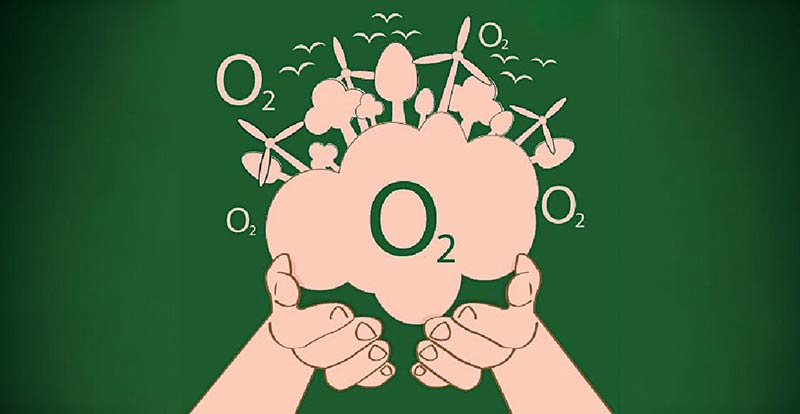
by Dr. Ranil Senanayake
The Oxygen that is present in the air that we breathe is the birth right of every organism that lives on this planet. It is free for everyone. However, the action of some to take out more than their share, without replacement, has created a condition, where the Global Commons of air is being rapidly degraded,
The most critical component of air is Oxygen. It surrounds us, filling our lungs with every breath we take. It is the invisible gift of nature that we take for granted. But this essential resource—the very foundation of life— is being constricted, because the volume of trees, plants, and photosynthetic organisms that produce oxygen is being lost across the planet. Further, there is no initiative for this generation capacity to be increased as a matter of urgency. exploited at present? Why couldn’t increasing the generation capacity of Oxygen have economic value? Could those who benefit most from using the resources of the Global Commons be required to contribute to its maintenance? This is the idea behind the Oxygen Economy, a bold and transformative concept that seeks to address environmental and social challenges in a way that is fair, sustainable, and forward-thinking beyond GDP value which measures the success of our societies today.
What Is the Oxygen Economy?
The Oxygen Economy is a financial framework, that recognises the value of the global stocks of Oxygen within the commons and records the deposition and consumption through economic activity.
The Oxygen Economy is a principled framework that recognises the stocks, transactions and deposits of Oxygen into the Global commons and assigns value to stocks from privately contracted production units, it stems from a growing recognition that Oxygen is a declining resource with an easy replenishment response.
Oxygen, considered a “free” resource. It is not. Much like oil and coal it is a ‘fossil’ resource that has been a part of the atmosphere for millions of years. It has been slowly declining, but is ‘topped up’ by a service provided by the earth’s ecosystems —particularly trees, plants, and other photosynthetic organisms. These organisms create molecular Oxygen through the process of photosynthesis, supporting life on earth and maintaining the balance of our atmosphere.
At its core, the Oxygen Economy aims to ensure that those who produce contracted and monitored oxygen, be it towns, farmlands, rural or forested lands, are fairly compensated for their efforts. It also holds industries and private-sector entities that benefit from oxygen consumption accountable in maintaining the sustainability of this resource.
What is the urgency to address oxygen as a depleting resource?
Other than the obvious fact of falling global stocks, the need of an Oxygen Economy arises from the urgency of addressing two critical challenges facing humanity: environmental degradation and economic inequality. Placing value on Oxygen production could effectively provide an effective response to both. For decades, efforts to combat climate change have focused primarily on carbon
sequestration. While important, the focus on Carbon sequestration often overlooks other vital ecosystem services, including oxygen production that can contribute towards a growing wealth paradigm. Oxygen, like water and food, is essential for life. However, unlike other resources, it has largely been treated as infinite and freely available, which it is not. In reality, the supply of Oxygen to the atmosphere is decreasing due to deforestation, while the consumption of Oxygen by space exploration, industrial production, war and transport are increasing. Today Oxygen levels have dropped by approximately 2%, raising concerns about the long- term sustainability of this critical resource.
How the Oxygen Economy works
The Oxygen Economy operates on the principles of private property being valued using financial tools such as valuation guarantees, stakeholder contracts and Insurances to monetise contractually produced oxygen as a financial product. This involves three key components:
1. Valuation guarantee:
Assigning an economic value to the oxygen produced by contracted and registered units in identified geographical areas of production is based on the researched, monitored and validated measurements of oxygen generation by trees / plants or photosynthetic organisms such as Cyanobacteria.
2. Deposition guarantee:
Issuance of certificates of completion and deposit of Oxygen into the global Commons Stakeholder Contracts and Compensation: Establishing formal agreements between oxygen consumers (e. g., corporations / Space exploration companies) and contracted oxygen producers (e.g., farmers, Local communities)
3. Policy and regulation: Introducing replicable legal frameworks at a regional scale to enforce accountability and prevent the uncontrolled exploitation of global oxygen resources.
Lessons from Sri Lanka
One country that is already exploring the potential of the Oxygen Economy is in the bioregional area of Sri Lanka. Known for its rich biodiversity and commitment to environmental stewardship, Sri Lanka has implemented initiatives that align with the principles of the Oxygen Economy. In one notable project, women from farming communities established and nurtured trees using contracts that measured and validated payments for photosynthetic biomass on an annually recurring basis for a period of four years. The stakeholders earning substantive income from this project were sensitised to the emerging Oxygen Economy while contributing their obligations to global environmental resilience. Over three years, these participants generated thousands of litres of oxygen, demonstrating that the concept is not only viable but also impactful.
Scaling the Oxygen Economy globally:
While Sri Lanka’s efforts are a promising start, the true potential of the Oxygen Economy
lies in its ability to scale globally. Imagine a world where farmers are compensated for the establishment of trees, where rural and even urban greenery projects could receive funding to expand their impact for this paradigm of business. Such a system would not only help combat climate change but also address economic inequalities of the current GDP paradigm, by together contracting the Oxygen economic asset tool to those who sustain the planet’s life-support systems.
Addressing potential challenges
Like any transformative idea, the Oxygen Economy faces potential challenges. Critics may argue that assigning a monetary value to Oxygen risks commodifying a natural resource that should remain freely accessible. Others may question the feasibility of measuring, validating and regulating oxygen production on a global scale. These concerns can be addressed by emphasising the ethical principles behind the Oxygen Economy. The goal is not to charge people for breathing but to ensure that those who contribute to its sustainability profit from financial contracts for Oxygen production. Additionally, such transparent systems for measuring and validating oxygen production will be crucial for building trust and ensuring fairness towards the vision of accounting for intergenerational wealth beyond the GDP framework that exists.
A vision for the future
The Oxygen Economy represents a paradigm shift in how we think about our relationship with the planet. It challenges us to move beyond the notion of nature as an infinite resource and to recognise the boundaries of our Global Commons. The true value of planet Earth is as an ecosystem that sustains life for all biota. By aligning economic practices with environmental stewardship, the Oxygen Economy offers a path towards a more equitable and sustainable future. It supports the foundations of intergenerational wealth that will be reflected in our contributions to the cycling atmospheric gasses of our Global Commons.
Imagine a world where the air we breathe is not taken for granted but is cherished and protected. Where farmers, communities, and ecosystems are rewarded for their contributions to the planet’s well-being. Where industries operate with a framework of accountability to prioritise the health of our shared environment. This is the vision of the Oxygen Economy—a vision that is within our reach if we act together, with urgency and determination, to lay well informed, solid foundations.
Features
Two sides to a coin; each mourn threat; no threat, no budget blues

 The coin Cassandra starts her Friday Cry with the recent film Rani. Parroting what her friends said on seeing the film, Cass in her Cry just prior to this wrote: “It has been reviewed as outstanding; raved over by many; and already grossed the highest amount in SL cinema history – Rs 100 million from date of release January 30 to February 14. This last: testimony to its popular appeal and acceptance as an outstanding cinema achievement.
The coin Cassandra starts her Friday Cry with the recent film Rani. Parroting what her friends said on seeing the film, Cass in her Cry just prior to this wrote: “It has been reviewed as outstanding; raved over by many; and already grossed the highest amount in SL cinema history – Rs 100 million from date of release January 30 to February 14. This last: testimony to its popular appeal and acceptance as an outstanding cinema achievement.
” Cass admitted she had not seen the film. She now realises her reluctance to jostle in the crowd in one of many cinemas retelling the murder of Richard de Zoysa and traumatic mourning of his mother, Manorani, was because there grew in her a distaste after watching short previews on YouTube of parts of the film. Most centered on is Swarna Mallawarachchi, starring as Manorani, downing alcohol and smoking cigarette after cigarette. Director Asoka Handagama was sensationlising the more dramatic incidents of the tragedy. That was to please the crowd.
We Sri Lankans, or many, have absolutely no tight upper lip. Most funerals of yesteryear and many rural ones still have writhing moaning and groaning and appeals to the dead to smile one more time, say a word, rise up. These loud gasped cries in between sobbing sent Cass wickedly into silent giggles. She thought: what if the dead obliged with even one request. Worst, if he rose up and sat in his coffin. The first to run away would be the callers! People love wallowing in sniffles of sorrow. Audiences much prefer fictionalised retelling of events to documentaries about them. Handagama does style his film as fictionalised history but he definitely is guilty of sensationalism. Cass’ gut feelings have been given words in a criticism on Face Book which was shared with Cass by a nephew.
The sent around message is titled: Misconceived, Misinterpreted, Miscast and a Big Mistake. That tells it all. However there follows an incisive critique of the film Rani by one of Richard’s friends who knew Manorani well and how she was after her son’s death. He signs himself, but Cass will not quote the name here since there is much truth, lies and even hidden agendas in what is posted on social media.
He writes: “Badly acted, badly directed and badly researched … A clear example of character assassination via a deliberate misuse of artistic license! … I want to state my opinion about two people that many of us loved, respected and knew intimately.” He then goes on to point out mistakes and exaggerations: Manorani was never even bordering on alcoholism and hardly ever smoked. And when she did, socially or to dim her sorrow, she did it elegantly. A Man Friday commented: they should have taught Swarna how to hold a cigarette and smoke it as it should be smoked. Hence my contention, every coin, even a box office success, has two sides to it, two diverse criticisms and in-betweens. Decision: Cass will not queue for a cinema ticket.
Each morn
Phoned a US living friend who was recovering from a harsh winter’s gift to her – severe flu. She said the flu was leaving her but depression and distraught-ness about hers and the US’s future were threatening to drown her in emotional turmoil much worse than the worst cough ‘n cold.
I knew the reason – Trump’s trumpets of new opinions, threats, enactments et al. She dreaded getting up each morning wondering what new calamity was to descend on the American people and by influence, spreading to the world. Her son has forbidden TV news watching and reading the newspapers which she says are so opposed to media treatment of the Prez.
I could very well sympathise with her. We in Sri Lanka suffered bouts of such threatened discomfort, nay calamitous warnings and sheer dread. My remembering mind went to Shakespeare in his tragic play Macbeth. Macduff’s description of Scotland under the reign of Macbeth to Malcolm, son and heir of murdered Duncan now sheltered in England, goes thus: “Each new morn/ New widows howl, new orphans cry/ new sorrows strike heaven on the face that it resounds.”
Cass does not know about you but dread lurked in her heart and mind when the JVP 1989 insurrection took place – for her teenage son. The LTTE and suicide bombs caused utter destruction of life, limb and infrastructure. Families who had travelled together now travelled to schools and workplaces separately since no bus or train was safe. Nor were the privately owned cars. Then came two tyrant Presidents with sudden deaths of prominent persons and media personnel like Richard and Lasantha and many others.
Blatant robbing of our money had us gasping helplessly. Riff raff rose in power and lorded, one such tying a man to a stake for not attending a meeting. Then rode to power on popular vote another brother in the newly created powerful dynasty. Word of mouth minus stroke of pen had orders given out to be promptly executed. White vans which plied the streets were reduced but worse happened.
One order and the rice fields had no grain, fruits dried on trees, forex earning luscious two leaves and a bud withered and could not be plucked. Bankruptcy resulted. But we had a ‘shipless’ harbour which had to be mortgaged for a song to the Chinese; a plane-less airport sounding death to elephants and peafowl; and a gaudy tower to gaze on or commit suicide from. A gathering of people on Galle Face Green righted things.
Then came into power a party that had two men and a woman in Parliament which yielded a true Sri Lankan with country first and last in mind, as President. Followed a sharp victory for the coalition of parties led by the hopefully reformed JVP so that three seats became almost two thirds of all seats in Parliament and a woman as Prime Minister. She had no connection to previous Heads unlike a former woman PM and Prez. The first woman PM rode to power weeping for her murdered husband; the younger very promising Prez because she was daughter of two Heads of Sri Lanka. But there was, even under their reign, mutterings and difficulties.
Truth be told, we sleep better at night and wake up with no dread in our innards. We rise to shine (if possible, in the heat of Feb) knowing people are working and corruption is not wrought by those in power. Thank goodness and our sensible voters for this peace we savour.
2025 Budget
Cass’ title has the phrase ‘no budget blues’. Looks like it is generally correct. Of course, the Opposition is criticising Finance Minister AKD’s presented budget. Cass is no economist, not by a long chalk, but she was glad to see that expenditure on health and education were substantial. We had a time when the armed forces were allocated more than education and health combined. Much has been looked into: including pregnant women and the Jaffna library among a host of mentioned amenities. We have no need to pessimistically await a Gazette Extraordinary stating negative segments of the future year’s financial plan. Thanks be!
Gaza and Ukraine are worse in position and the world is awry. But Sri Lanka is in a phase where Kuveni’s curse is stilled and people are considering themselves Sri Lankans, uniting to re-make Sri Lanka Clean as it was before selfish corrupt politicians took over.
Features
As Africa toes Chinese line …
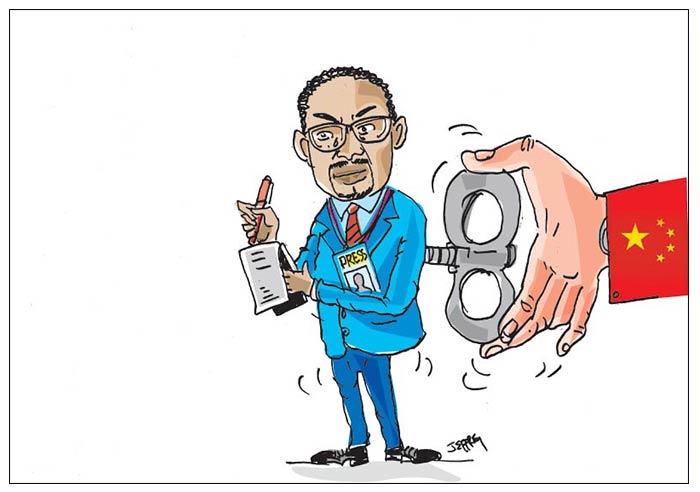
Mitchell Gallagher
Every year, China’s minister of foreign affairs embarks on what has now become a customary odyssey across Africa. The tradition began in the late 1980s and sees Beijing’s top diplomat visit several African nations to reaffirm ties. The most recent visit, by Foreign Minister Wang Yi, took place in mid-January 2025 and included stops in Namibia, the Republic of the Congo, Chad and Nigeria.
For over two decades, China’s burgeoning influence in Africa was symbolised by grand displays of infrastructural might. From Nairobi’s gleaming towers to expansive ports dotting the continent’s shorelines, China’s investments on the continent have surged, reaching over $700 billion by 2023 under the Belt and Road Initiative, China’s massive global infrastructure development strategy.
But in recent years, Beijing has sought to expand beyond roads and skyscrapers and has made a play for the hearts and minds of African people. With a deft mix of persuasion, power and money, Beijing has turned to African media as a potential conduit for its geopolitical ambitions. Partnering with local outlets and journalist-training initiatives, China has expanded China’s media footprint in Africa. Its purpose? To change perceptions and anchor the idea of Beijing as a provider of resources and assistance and a model for development and governance. The ploy appears to be paying dividends, with evidence of sections of the media giving favourable coverage to China.
But as someone researching the reach of China’s influence overseas, I am beginning to see a nascent backlash against pro-Beijing reporting in countries across the continent. China’s approach to Africa rests mainly on its use of “soft power,” manifested through things like the media and cultural programmes. Beijing presents this as “win-win cooperation”—a quintessential Chinese diplomatic phrase mixing collaboration with cultural diplomacy. Key to China’s media approach in Africa are two institutions: The China Global Television Network (CGTN) Africa and Xinhua News Agency.
CGTN Africa, which was set up in 2012, offers a Chinese perspective on African news. The network produces content in multiple languages, including English, French and Swahili, and its coverage routinely portrays Beijing as a constructive partner, reporting on infrastructure projects, trade agreements and cultural initiatives. Moreover, Xinhua News Agency, China’s state news agency, now boasts 37 bureaus on the continent. By contrast, Western media presence in Africa remains comparatively limited.
The BBC, long embedded due to the United Kingdom’s colonial legacy, still maintains a large footprint among foreign outlets, but its influence is largely historical rather than expanding. And as Western media influence in Africa has plateaued, China’s state-backed media has grown exponentially. This expansion is especially evident in the digital domain. On Facebook, for example, CGTN Africa commands a staggering 4.5 million followers, vastly outpacing CNN Africa, which has 1.2 million—a stark indicator of China’s growing soft power reach. China’s zero-tariff trade policy with 33 African countries showcases how it uses economic policies to mould perceptions.
And state-backed media outlets like CGTN Africa and Xinhua are central to highlighting such projects and pushing an image of China as a benevolent partner. Stories of an “all-weather” or steadfast China-Africa partnership are broadcast widely and the coverage frequently depicts the grand nature of Chinese infrastructure projects. Amid this glowing coverage, the labour disputes, environmental devastation or debt traps associated with some Chinese-built infrastructure are less likely to make headlines. Questions of media veracity notwithstanding, China’s strategy is bearing fruit.
A Gallup poll from April 2024 showed China’s approval ratings climbing in Africa as US ratings dipped. Afrobarometer, a pan-African research organisation, further reports that public opinion of China in many African countries is positively glowing, an apparent validation of China’s discourse engineering. Further, studies have shown that pro-Beijing media influences perceptions. A 2023 survey of Zimbabweans found that those who were exposed to Chinese media were more likely to have a positive view of Beijing’s economic activities in the country. The effectiveness of China’s media strategy becomes especially apparent in the integration of local media.
Through content-sharing agreements, African outlets have disseminated Beijing’s editorial line and stories from Chinese state media, often without the due diligence of journalistic scepticism. Meanwhile, StarTimes, a Chinese media company, delivers a steady stream of curated depictions of translated Chinese movies, TV shows and documentaries across 30 countries in Africa. But China is not merely pushing its viewpoint through African channels. It’s also taking a lead role in training African journalists, thousands of whom have been lured by all-expenses-paid trips to China under the guise of “professional development.” On such junkets, they receive training that critics say obscures the distinction between skill-building and propaganda, presenting them with perspectives conforming to Beijing’s line.
Ethiopia exemplifies how China’s infrastructure investments and media influence have fostered a largely favourable perception of Beijing. State media outlets, often staffed by journalists trained in Chinese-run programmes, consistently frame China’s role as one of selfless partnership. Coverage of projects like the Addis AbabaDjibouti railway line highlights the benefits, while omitting reports on the substandard labour conditions tied to such projects—an approach reflective of Ethiopia’s media landscape, where state-run outlets prioritise economic development narratives and rely heavily on Xinhua as a primary news source. In Angola, Chinese oil companies extract considerable resources and channel billions into infrastructure projects.
The local media, again regularly staffed by journalists who have accepted invitations to visit China, often portray Sino-Angolan relations in glowing terms. Allegations of corruption, the displacement of local communities and environmental degradation are relegated to side notes in the name of common development. Despite all of the Chinese influence, media perspectives in Africa are far from uniformly pro-Beijing. In Kenya, voices of dissent are beginning to rise and media professionals immune to Beijing’s allure are probing the true costs of Chinese financial undertakings. In South Africa, media watchdogs are sounding alarms, pointing to a gradual attrition of press freedoms that come packaged with promises of growth and prosperity.
In Ghana, anxiety about Chinese media influence permeates more than the journalism sector, as officials have raised concerns about the implications of Chinese media cooperation agreements. Wariness in Ghana became especially apparent when local journalists started reporting that Chinese-produced content was being prioritised over domestic stories in state media.
Beneath the surface of China’s well publicised projects and media offerings, and the African countries or organisations that embrace Beijing’s line, a significant countervailing force exists that challenges uncritical representations and pursues rigorous journalism. Yet as CGTN Africa and Xinhua become entrenched in African media ecosystems, a pertinent question comes to the forefront: Will Africa’s journalists and press be able to uphold their impartiality and retain intellectual independence? As China continues to make strategic inroads in Africa, it’s a fair question.
(The writer is a PhD candidate of political science at Wayne State University, US. This article was published on www.theconversation.com)
-

 Sports6 days ago
Sports6 days agoRemarkable turnaround for Sri Lanka’s ODI team
-
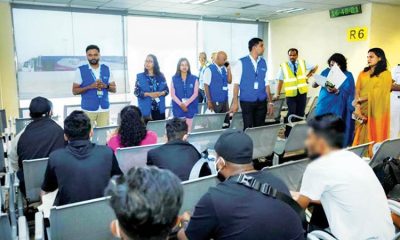
 Features6 days ago
Features6 days agoScammed and Stranded: The Dark Side of Sri Lanka’s Migration Industry
-
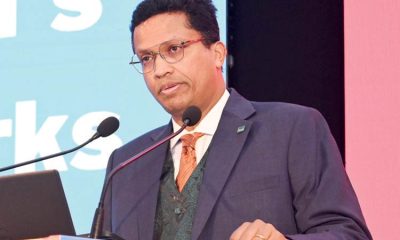
 Business6 days ago
Business6 days agoUN Global Compact Network Sri Lanka: Empowering Businesses to Lead Sustainability in 2025 & Beyond
-
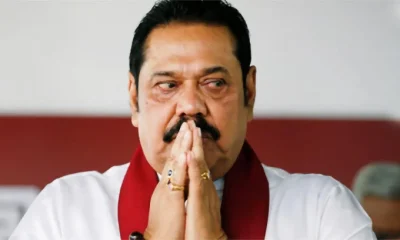
 Features5 days ago
Features5 days agoDon’t betray baiyas who voted you into power for lack of better alternative: a helpful warning to NPP – II
-

 News3 days ago
News3 days agoCommercial High Court orders AASSL to pay Rs 176 mn for unilateral termination of contract
-
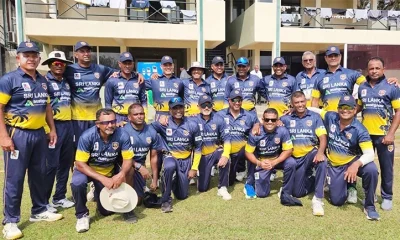
 Sports2 days ago
Sports2 days agoSri Lanka face Australia in Masters World Cup semi-final today
-
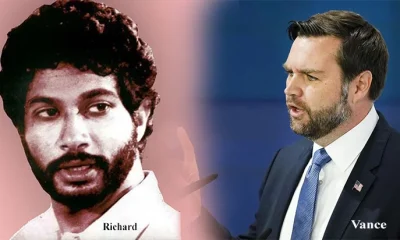
 Features5 days ago
Features5 days agoTwo films and comments
-
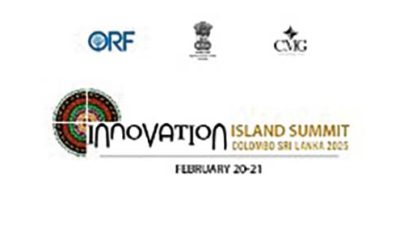
 News6 days ago
News6 days agoInnovation Island Summit 2025, Colombo, Sri Lanka




